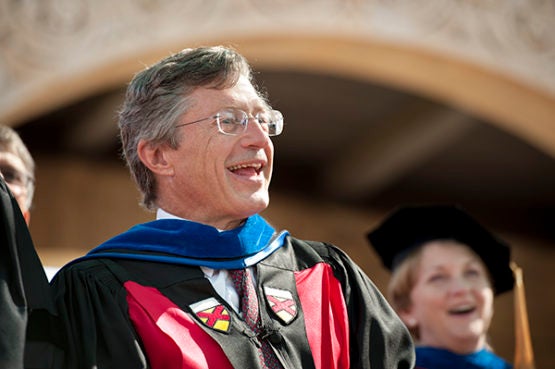Provost John Etchemendy leaves remarkable legacy
John Etchemendy, Stanford’s longest-serving provost, leaves a legacy featuring a strengthened academic program, a modernized campus, an unrivaled financial aid program and a culture of collaboration that will last for years.
When John Etchemendy exits his office in Building 10 for the last time on Jan. 31, he will leave as Stanford’s longest-serving provost and with a legacy that encompasses progress in every corner of the university.
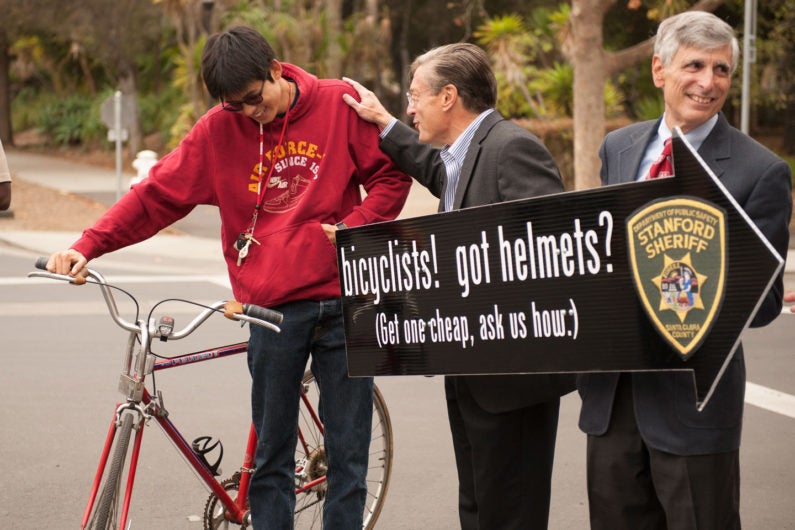
Provost John Etchemendy, center, and then Medical School Dean Philip Pizzo provide graduate student Alexander Hsu with a friendly reminder to wear a bicycle helmet. Promoting bicycle safety among students was one of Etchemendy’s particular concerns. (Image credit: L.A. Cicero)
For the remainder of the academic year, Etchemendy will serve as special assistant to President Marc Tessier-Lavigne and incoming Provost Persis Drell to help in the continuing administrative transition. He will then take a year-long sabbatical before returning to teach philosophy, higher education and leadership.
Trying to enumerate Etchemendy’s accomplishments during the past 17 years fails to do justice to what he has meant to Stanford. Those with whom he has worked closest say it’s not just what Etchemendy did that made a difference; it’s also how he did it that will make such a long-lasting impact. Still, a small sample of numbers suggests how strong his imprint on the life of the university has been:
- Since 2000, Etchemendy has hired all seven school deans and every academic vice provost, while overseeing the hiring of an astonishing 80 percent of Stanford’s faculty members.
- More than 70 major building projects have been completed since 2000, including the $500 million Stanford Energy System Innovations effort, which has reduced greenhouse gas emissions 68 percent and resulted in one of the most sustainable campuses nationwide.
- In the 2008 recession, despite experiencing a 30 percent drop in its endowment, Stanford introduced the largest increase in its history for undergraduate financial aid. Seventy-nine percent of graduates today have no student debt.
- The percentage of female and minority faculty has grown thanks to such programs as the Faculty Development Initiative and the Faculty Incentive Fund, while the pipeline for minorities to academic careers has been fortified with such programs as DARE – Diversifying Academia, Recruiting Excellence.
- Undergraduate applications more than doubled, and financial support, services and housing for the university’s more than 9,000 graduate students grew exponentially.
Any list of accomplishments, however, is unlikely to impress the modest Etchemendy, who eschews the spotlight and diverts credit to others. Being provost, he contends, is like leading a diverse armada of vessels, ranging from ocean liners to fishing schooners. Deans, department chairs, office managers and the like know their ships well and how to steer them best. The job of a provost, he says, is to “try to get people moving in the right direction,” adding, “When you have the right people in place, your job is easy.”
Challenging job
His protestations aside, Etchemendy has done what is arguably one of the most challenging jobs in higher education – and he has done it with an unwavering commitment to excellence in everything. Unlike at peer institutions, Stanford’s provost serves as both the chief academic and budgetary officer, administering the teaching and research program while coordinating many of the administrative functions supporting the university’s academic mission. Stanford is a robust $5.5 billion enterprise that is challenging to steer both academically and financially because it is decidedly decentralized.
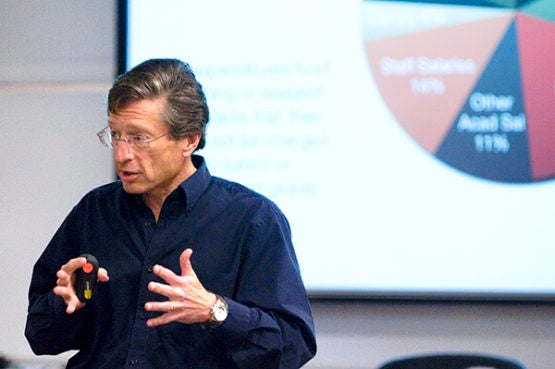
Etchemendy earned praise for leading the university through financially challenging times. (Image credit: L.A. Cicero)
The challenges of the job were never lost on former President John Hennessy, who appointed Etchemendy to the position and preceded him as provost. The creative partnership the two created, characterized by trust and respect, has been widely recognized as the foundation for Stanford’s remarkable ascent during recent years in virtually every higher education milestone.
“He was an outstanding provost,” Hennessy said, citing Etchemendy’s ability to navigate financial challenges while still investing in financial aid, the attraction and retention of an outstanding faculty and his partnership with Land, Buildings and Real Estate in reimagining the physical campus through buildings constructed on or under budget. He did it all, Hennessy adds, “with the patience of Job.”
“The job of provost is a tough one – in many ways harder than the president’s,” Hennessy said. “That’s because you have to say no. To do that in a way that people feel listened to and respected – and to do so with patience and calmness – that’s hard.”
Respect for Etchemendy also resonates in the larger higher education community and especially among peers in the Ivy Plus Provosts group, whose members meet to discuss issues of mutual concern. Alan Garber, who was a Stanford faculty member before becoming Harvard’s provost, remembered working with Etchemendy when he was a philosophy and symbolic systems professor, director of the Center for the Study of Language and Information and member of the University Advisory Board. In his nearly 35 years as a faculty member at Stanford, Etchemendy has also served as chair of philosophy and associate dean for the School of Humanities and Sciences. He earned his doctorate in philosophy at Stanford in 1982.
“In every respect, he did an extraordinary job,” Garber said. “Brilliant, intellectually curious, with far-ranging academic interests, he was also fair, tactful, humane, wise and utterly devoted to Stanford. When I became a provost myself, I gained a new appreciation for how he conducted himself and for all that he accomplished. At the last Ivy Plus Provosts meeting, which was held at Stanford, the respect and affection for John was palpable. He is an inspiration at Stanford and beyond.”
‘Hey, Etch’
Affection for Etchemendy is obvious throughout campus, where he is universally known by his nickname, Etch. At an official gathering, you introduced him as Provost Etchemendy, befitting the respect due the office. When you passed him in the Main Quad or at the gym, you’d say, “Hey, Etch,” reflecting the approachability of the man. He returned the affection in kind. Etchemendy never missed an opportunity in countless speeches to call faculty the most outstanding worldwide, staff the best in the nation and students the most gifted anywhere.
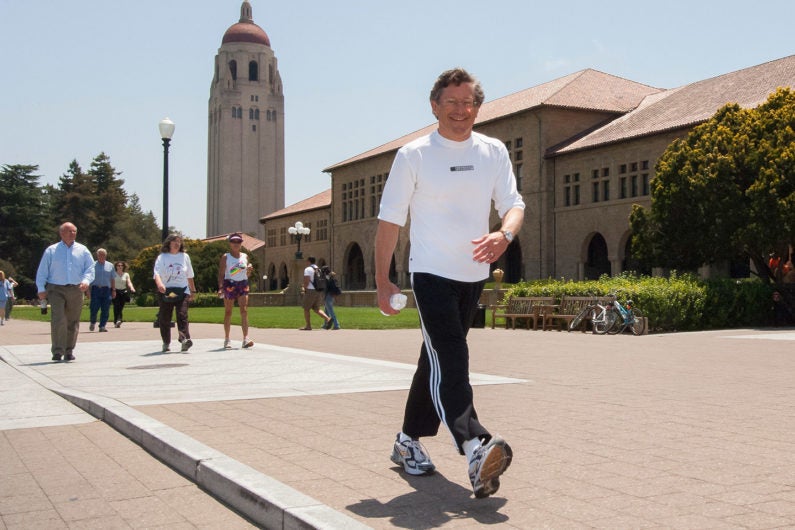
As provost, Etchemendy led the effort to encourage a healthy lifestyle for all Stanford employees and often led BeWell’s annual Cardinal Walk. (Image credit: L.A. Cicero)
Richard Saller, dean of the School of Humanities and Sciences, said Etchemendy’s approachability and generosity go hand in hand with the collaborative and non-territorial management style he worked hard to create among the university’s academic leadership. The effect trickled down, and Saller cites the resulting collaborative campus-wide culture as another of Etchemendy’s lasting legacies. He made it possible for deans and other campus leaders to eschew the competitive chest-thumping prevalent in so many academic hierarchies.
Explained Persis Drell, dean of the School of Engineering and incoming provost, “John always inspired us to think about what was best for Stanford. And that led naturally to a collaborative engagement among the deans rather than competitive. John was also wonderful at supporting us individually and collectively.”
That collaborative approach, combined with confidence in his integrity and in his commitment to the university, earned Etchemendy what Saller called “a very deep level of trust,” especially among faculty members.
His reputation for building strong faculty relationships prompted many universities nationwide to ask Etchemendy to be a candidate for their presidencies. When a student journalist followed up on word that Etchemendy was being courted by her institution, she interviewed him for a 2007 article called “Stretch for Etch.” He politely assured her he was not a candidate, explaining that he already had “the best position in higher education.”
Etchemendy needed every ounce of the trust he built on campus when he and Hennessy instituted budget cuts in the wake of the 2008 economic downturn. The university’s endowment value plunged 30 percent, reducing the flow of investment returns into the operating budget. In a detailed, hour-long presentation, Etchemendy explained to fellow faculty members with as much transparency as his charts and graphs could muster what needed to be done. Getting the pain over with quickly, he asserted, was the best approach.
“He received a round of applause from the faculty that struck me as extraordinary. I mean, it was a budget talk about cuts,” Saller said. “It was a sign of their confidence in him.”
The approach proved successful. Within a year after a hiring freeze, layoffs and construction delays, Stanford began to recover and rebuild, while colleges and universities that had delayed hard decisions were still reeling.
Sense of humanity
“He does believe in the truth as a logician,” Saller said, explaining how Etchemendy’s background as a philosophy scholar specializing in logic gave rise to his straightforward approach to tackling challenges. “Not in a cold, academic way – but nuanced with a deep sense of humanity.”
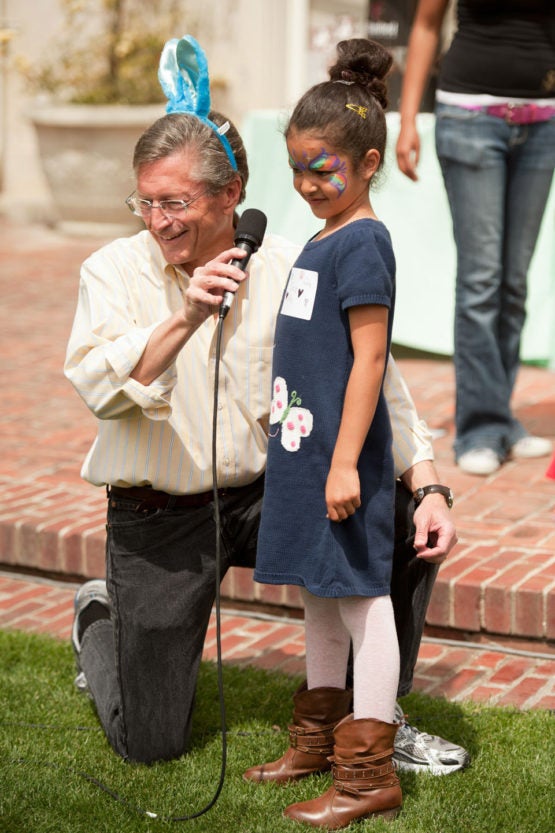
Etchemendy increased support for Stanford’s graduate students, here sponsoring an Easter egg hunt at his home for graduate students and their families. (Image credit: L.A. Cicero)
Stephanie Kalfayan, vice provost for academic affairs, suggested that being the middle child in his family nurtured Etchemendy’s ability to find common ground and resolve problems. “He approached everything believing that we are all Stanford and that everyone is important to the university,” she said. “Your gain is not someone else’s loss.”
It often fell to Etchemendy to deliver hard truths about issues ranging from finances to alcohol to sexual violence. In his annual welcome to parents during New Student Orientation (NSO), for instance, he would forgo pleasantries to raise the difficult issue of alcohol abuse and ask for help in diminishing the drinking culture on campus. First-year students at NSO heard Etchemendy outline his expectations that they would respect the Honor Code and Fundamental Standard and live up to the ideals articulated by students before them.
Difficult truths, however, were always sprinkled with enough humor – much of it self-deprecating – to make them palatable. For instance, in his speeches to students, Etchemendy would often remind them with a wry grin that the original meaning of provost was “jailer” and that he, too, understood the fear that his admission to Stanford was a mistake. He got over that feeling, he told them, “about the time they made me provost, I guess.”
One of the toughest challenges Etchemendy confronted was the issue of sexual assault. In 2010, Etchemendy told the university community that Stanford would confront sexual violence on campus head-on, but that the process of cultural change would be difficult. It has, in fact, been at times heartbreaking. Through it all, however, Stanford has persevered to create one of the most extensive Title IX educational, support and adjudication programs in the nation.
BeWell at Stanford
With all that Etchemendy has accomplished, it’s easy to forget that his health almost cut short his tenure as provost. Four years into the job, he acknowledged that he had gained weight, was suffering insomnia and leading a sedentary lifestyle involving too many meetings and too much computer time.
“My worst fear was that I would be physically unable to continue as provost, a job I loved,” Etchemendy wrote in a Stanford Report opinion piece. “I’d saved an email that a friend had sent me years earlier, outlining her success with a fitness trainer. I asked my wife, Nancy, if she would find me a personal trainer. At the time, I felt too overwhelmed to even do so myself. Nancy quickly found a gym and trainer for me, and the following Saturday I began a five-year odyssey to fitness.”
Etchemendy emerged from that odyssey determined that everyone else at Stanford would have the opportunity to experience the same transformation. BeWell@Stanford was born from the university’s already considerable health improvement offerings. As a result of its combination of incentives, exercise classes, wellness courses and personal health advising, two-thirds of surveyed employees say BeWell substantially enhances their work experience.
In recognition of Etchemendy’s support, Eric Stein, senior associate athletic director; Wes Alles, who directed the Health Improvement Program; and their BeWell team renamed the annual springtime, 1.25-mile Cardinal Walk in his honor. Stein and Alles say the recognition surprised Etchemendy. “He’s such a humble guy,” Stein said, adding, “But he didn’t say no.”
Stein and Alles believe BeWell has created a community of wellness at Stanford that changes lives as students, faculty and staff realize the benefits of a healthy living style. “It made people know that the university cared about them as people,” Stein said. “We hope he appreciates how much his philosophy of wellness has impacted the lives of so many people.”
Etchemendy is also credited with supporting other benefits that recognize the family-related needs of faculty and staff, including elder and child care programs. Since 2000, child care capacity on campus has more than doubled through the construction of facilities that set Stanford apart from its peers and among employers in Silicon Valley, according to Phyllis Stewart Pires, senior director of WorkLife strategy.
The provost, she said, strategically understood and appreciated the recruitment and retention benefits of such programs. “But what always impressed me most in working with John,” she said, “was the way he demonstrated so much compassion for individual situations.”
Devoted to Stanford
It is devotion to the university that motivates Etchemendy and has led to the genuine affection he feels for members of the community, according to Kalfayan.
“He has made enormous sacrifices for this institution because he is devoted to it,” she said. “The amount of time he has dedicated to everything is considerable. For instance, John wouldn’t just make a decision about a building site based on recommendations he received. He’d come get me and say, ‘Let’s take a walk over there.’ That’s how he has done everything. He even picks up garbage when he sees it.”
Etchemendy’s sister, Jonrie Dávila, a Stanford graduate, credits her brother’s devotion to Stanford to the initial influence of their mother, who grew up during the Great Depression and attended the university’s former nursing program thanks to scholarship assistance. She instilled in her children, Dávila said, a “lifelong respect for and gratitude to the university.”
Dávila said their family’s experience made Etchemendy deeply committed to financial aid, especially for middle-class students stressed by the cost of higher education.
“From the time he was appointed provost, John expressed deep concern that Stanford could become financially unavailable for any student whose family was neither very low income nor very well-off,” said Dávila. “He wanted to ensure that Stanford would be affordable to middle-income families. His goal was to make a Stanford education more affordable to a middle-class family with two or more students in college than attending the University of California.”
Etchemendy himself never benefited from Stanford’s generous financial aid program. He was denied admission as an undergraduate. When he later applied for the graduate program in philosophy, he found himself on a waiting list. He credits his eventual admission to an administrator whom he spoke to almost every day, asking whether a position had opened up.
He shared the story at a conference of Stanford administrative assistants in 2005. The story helps explain Etchemendy’s affection for and appreciation for Stanford staff members.
“On the very last day to decide where I would go, I called Stanford one last time,” he said. “The administrator answered, heard it was me, and asked me to wait one moment. She put the phone down, and I heard her walk into the hall where she accosted the department chair. ‘Ian,’ she said rather sharply, ‘you just have to let this young man know whether he can come.’ I couldn’t hear what else she said, but in a moment the chair came on the phone and offered me a spot in the incoming class. I’m convinced that I’m here at Stanford now thanks to that staff member’s concern for me as a person.”
What’s left
As he prepares to move out of his office to make way for Drell, Etchemendy was asked if there is anything he has left undone – any objective he wishes he could have completed.
“Everything is left undone,” he said. “I remember when I was an assistant professor, and it always seemed like the university was under construction. I wondered when the university was going to be ‘done.’ But I came to realize that universities are like cities. They are constantly evolving. They are never done.”

